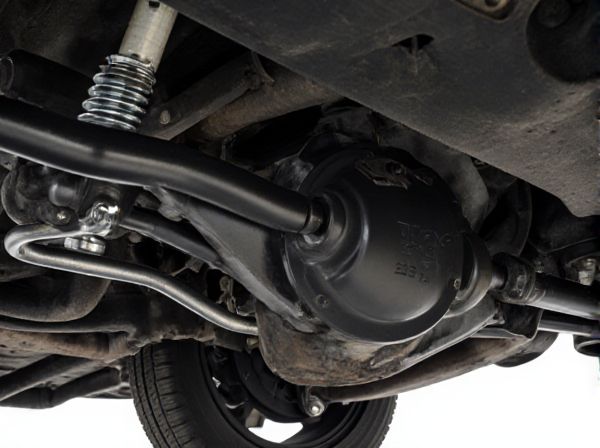
Photo illustration: Multi-Link vs Twist Beam
A Multi-Link suspension system offers superior ride comfort and handling by allowing each wheel to move independently, improving traction and stability on uneven roads. A Twist Beam suspension is simpler and more cost-effective, providing decent performance but less precision compared to Multi-Link setups. Your choice depends on whether you prioritize sporty driving dynamics or budget-friendly maintenance.
Table of Comparison
| Feature | Multi-Link Suspension | Twist Beam Suspension |
|---|---|---|
| Design | Multiple arms connected independently | Single beam with twisting action |
| Ride Comfort | Superior, absorbs road imperfections well | Moderate, less effective on rough surfaces |
| Handling | Improved stability and cornering control | Basic handling, less precise |
| Cost | Higher due to complexity and components | Lower, simpler and cheaper to produce |
| Space Efficiency | Requires more space in chassis | Compact and space-saving design |
| Maintenance | More complex, higher maintenance costs | Simple, lower maintenance costs |
| Weight | Heavier due to multiple parts | Lighter, less components |
| Common Usage | Premium sedans, sports cars, SUVs | Economy cars, compact hatchbacks |
Introduction to Suspension Systems
Multi-Link suspension systems offer superior ride comfort and handling by allowing independent wheel movement, enhancing traction and stability on uneven surfaces. Twist Beam suspensions, commonly found in economy cars, provide a cost-effective, compact design with fewer components but less adaptability to complex road conditions. Understanding the differences helps in selecting the appropriate system for performance, cost, and driving experience preferences.
What is a Multi-Link Suspension?
A Multi-Link Suspension is a vehicle suspension system that uses three or more arms to control wheel movement, offering precise handling and improved ride comfort. It allows each wheel to move independently, reducing road noise and enhancing traction on uneven surfaces. This design contrasts with the simpler Twist Beam suspension, providing better adaptability for performance and luxury vehicles.
What is a Twist Beam Suspension?
Twist beam suspension is a semi-independent rear suspension system widely used in compact and mid-sized vehicles due to its cost-effectiveness and simplicity. It consists of a beam that connects the two rear wheels, allowing limited torsional movement to provide a balance between ride comfort and handling stability. Compared to multi-link suspension, twist beam offers less precise wheel control but occupies less space and reduces manufacturing complexity.
Key Differences: Multi-Link vs Twist Beam
Multi-Link suspension provides independent wheel movement on each side, enhancing ride comfort and handling precision, while Twist Beam suspension connects wheels via a beam that twists, offering a simpler, lighter, and more cost-effective design. Multi-Link systems are typically found in higher-end or performance vehicles due to their superior road handling and adaptability to varying road conditions. Twist Beam suspensions are common in compact or economy cars where space efficiency and lower manufacturing costs are prioritized over advanced ride dynamics.
Ride Comfort Comparison
Multi-link suspension systems offer superior ride comfort by providing independent wheel movement that reduces vibrations and improves handling on uneven surfaces. Twist beam suspensions, while more cost-effective and simpler, tend to transmit more road irregularities to the cabin due to their semi-independent design, leading to a firmer and less refined ride experience. The enhanced flexibility and precision of multi-link setups make them the preferred choice for vehicles prioritizing smoothness and passenger comfort over ruggedness or budget constraints.
Handling and Performance Analysis
Multi-link suspension systems deliver superior handling and performance by allowing independent wheel movement, which enhances traction and reduces body roll during cornering. Twist beam suspensions, while simpler and lighter, provide less precise control and may exhibit increased understeer due to their semi-independent design. Performance analysis shows multi-link setups excel in dynamic stability and ride comfort, making them preferred in sports and luxury vehicles.
Cost and Maintenance Considerations
Multi-Link suspension systems generally incur higher initial costs due to their complex design and increased number of components, requiring specialized tools and expertise for maintenance. Twist Beam suspensions offer a cost-effective alternative with simpler construction, resulting in lower repair and replacement expenses over time. Maintenance for twist beam setups tends to be more straightforward, reducing labor time and long-term ownership costs compared to multi-link systems.
Suitability for Different Vehicle Types
Multi-link suspension systems offer superior handling and ride comfort, making them ideal for high-performance vehicles, luxury sedans, and SUVs requiring precise wheel control. Twist beam suspensions, characterized by their simpler design and cost-effectiveness, are best suited for compact cars and budget-friendly vehicles where space efficiency and manufacturing affordability are priorities. The choice between multi-link and twist beam heavily depends on vehicle weight, intended use, and driving dynamics, influencing overall stability and passenger comfort.
Real-World Examples and Applications
Multi-link suspension is commonly used in luxury and performance vehicles like the BMW 3 Series and Audi A4, offering superior handling and ride comfort by allowing independent wheel movement and precise control. Twist beam suspension is favored in compact and economy cars such as the Volkswagen Polo and Ford Fiesta due to its cost-effective design, simpler construction, and adequate performance for urban driving. Real-world applications highlight multi-link's advantage in delivering stability and agility on varied terrains, while twist beam excels in durability and space efficiency in smaller vehicles.
Which Suspension System is Right for You?
Multi-link suspension offers enhanced handling, ride comfort, and improved traction by allowing each wheel to move independently, making it ideal for performance-oriented and luxury vehicles. Twist beam suspension is more cost-effective, simpler, and space-efficient, providing adequate stability and comfort for everyday driving in compact and economy cars. Choosing between the two depends on your driving preferences, budget, and vehicle type, with multi-link suited for drivers seeking superior ride quality and twist beam for practical, budget-conscious use.
 caratoz.com
caratoz.com